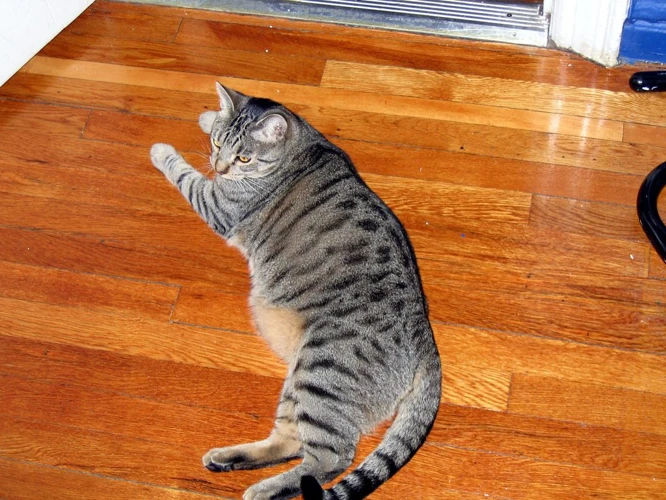Bringing a new California Spangled cat home can be a joyous experience. However, as a responsible owner, it’s important to house train your furry friend to prevent unwanted messes around the house. House training a California Spangled cat can seem daunting at first, but with the right approach, equipment, and patience, the process can be smooth and successful. In this article, we’ll go over the basics of house training your California Spangled cat step by step, as well as how to troubleshoot common issues along the way. By the end, you’ll feel more confident in your ability to train your new feline companion.
Understanding Your California Spangled’s Behavior

Understanding the behavior of your California Spangled cat is crucial to successfully house train them. Cats are naturally inclined to bury their waste in soil or sand, so using a litter box comes naturally to most cats. However, each cat is unique and may have different preferences or habits when it comes to using a litter box. It’s important to pay attention to your cat’s behavior and cues in order to provide them with the best possible training. In this section, we’ll discuss the importance of positive reinforcement, recognizing your cat’s signals, and the necessity of patience when training your California Spangled. For more information about house training your California Spangled kitten or adult cat, check out our Cali Spangled Cat House Training guide.
The Importance of Positive Reinforcement
Positive reinforcement is a key aspect when house training your California Spangled Cat. Using a reward-based system can help to ensure that your cat forms good habits and learns that using the litter box or designated potty area is positive behavior.
What is positive reinforcement?
Positive reinforcement involves rewarding good behavior to encourage its continuation. In the case of house training your California Spangled, positive reinforcement is used to encourage your cat to use the designated potty area. Rewards can include treats, verbal praise, or playtime.
How to use positive reinforcement with your California Spangled
When your cat uses the litter box or designated potty area, be sure to offer verbal praise, pets, or a small treat to reinforce this positive behavior. You should do this consistently as your cat forms the habit of using the designated area.
It is important to note that positive reinforcement should not be used to punish your California Spangled for bad behavior. Punishing your cat can lead to confusion and anxiety, making it more difficult to house train them. Instead, focus on rewarding good behavior.
The benefits of positive reinforcement
Using positive reinforcement when house training your California Spangled can have a range of benefits. These include:
- Encouraging good behavior: By rewarding your cat for using the litter box or designated potty area, you encourage the formation of good habits.
- Strengthening the human-cat bond: Positive reinforcement helps to establish a trusting relationship between you and your cat.
- Reinforcing litter box habits: Consistently rewarding good behavior helps to strengthen the habits of using the litter box or designated potty area.
By using positive reinforcement, you can help to establish good habits in your California Spangled that will benefit them throughout their lives.
If you are house training a California Spangled Kitten, read our article about house training tips for kittens. If you are experiencing litter box problems, such as your cat refusing to use the litter box, read our article about common litter box problems and solutions. If you are having issues with an adult cat, you can read our article on troubleshooting issues with house training adult cats. Additionally, you can try using clicker training to reinforce positive behavior, learn how in our article about clicker training for cats.
Recognizing Your Cat’s Signals
Understanding your California Spangled cat’s signals is crucial to successful house training. Here are some key indicators to look out for:
- Scratching and/or digging – Your cat may scratch or dig in a specific area to signal their need to use the restroom. If you notice this behavior, quickly move them to their designated potty area.
- Pacing and meowing – Some cats may pace back and forth with an anxious meow, indicating it’s time to go outside or to the litter box.
- Sniffing and circling – Before they go, some cats may sniff intently at a spot, followed by circling around it. Immediately move your cat to their designated area if you notice this behavior.
- Restlessness or agitation – Your cat may become restless or agitated, perhaps even hiding, when they need to relieve themselves. Be mindful of this behavior, as it could mean they need to use the bathroom.
Remember that each cat may have their unique way of communicating their need to go potty, so it’s essential to pay attention to their behavior and actions. Taking the time to learn your cat’s habits and signals can make the house training process significantly easier and less frustrating for both you and your furry friend.
Patience is Key
When it comes to house training your California Spangled cat, patience is key. Remember, your cat is a creature of habit and it can take some time for them to adjust to their new routine and learn where to go to the bathroom.
To help you stay patient during this process, it can be helpful to create a plan that outlines your goals and expectations. Use the following table as an example:
| Goal/Expectation | Timeline | Action Step |
|---|---|---|
| Establish a potty area | Week 1 | Choose a location and add litter box |
| Encourage use of potty area | Weeks 2-3 | Reward cat for using litter box and give gentle reminders when needed |
| Consistently use potty area | Weeks 4-6 | Continue positive reinforcement and adjust routine as necessary |
It’s important to remember that every cat is different and may take more or less time to adjust to their new routine. Be patient and celebrate small victories along the way. Don’t get discouraged by setbacks, instead, reevaluate your plan and make adjustments as necessary. With time and consistency, your California Spangled cat will become a pro at using their designated potty area.
The Basics of House Training Your California Spangled

Training a California Spangled Cat to use the litter box is an important part of being a cat owner. This process can be daunting, but with the right techniques, it can be done successfully. It’s essential to have the proper equipment and patience to teach your feline friend where to go potty. In this section, we will learn about everything you need to know to teach your California Spangled how to use the litter box with ease and comfort. Let’s dive into the essential steps for house training your California Spangled Cat.
Starting with the Proper Equipment
Before embarking on house training your California Spangled cat, it’s essential to ensure that you have all the necessary equipment to make the process as smooth and efficient as possible. Here is a list of the essential equipment you’ll need to get started:
- A litter box: This is the most important piece of equipment you’ll need when house training your cat. Look for a litter box that is big enough for your cat to comfortably turn around in and deep enough to prevent the litter from spilling.
- Litter: Choose a low-dust, unscented litter that your cat finds comfortable to use. Some cats prefer clumping litter, while others prefer non-clumping.
- Scoop: A litter scoop will make cleaning up after your cat much easier. Plan to scoop the litter box at least once a day.
- Enzymatic Cleaner: Inevitably, there will be accidents during the training process, so it’s important to be prepared. An enzymatic cleaner will break down any biological matter that your cat may leave behind, preventing future accidents in the same spot.
- Closed storage container: Store the litter and litter box cleaning supplies in a closed container to prevent curious pets from getting into it.
Having the right equipment is only the first step in house training your California Spangled cat. It’s equally important to set up a designated potty area, establish a routine, and understand how to deal with accidents when they happen. By taking your time and using positive reinforcement, you’ll soon have a well-trained, happy, and healthy cat who knows where to take care of business.
Setting up a Designated Potty Area
Choosing a designated potty area for your California Spangled cat is key to successful house training. Here are some steps to follow:
- Choose a location: Choose a location in your home that is easily accessible for your cat. This can be in a quiet and secluded room, or in an area that is close to their food and water bowls.
- Select the appropriate potty equipment: Decide what type of litter box you will use. Some cats prefer open boxes, while others prefer covered boxes. You should also consider the size of the litter box based on the size of your cat.
- Get the right type of litter: Some cats are picky about their litter. You may need to experiment with different types until you find one your California Spangled likes. There are many different types of litter on the market, including clumping, non-clumping, scented, and unscented.
- Place the litter box in the designated area: Once you have selected the litter box and litter, place it in the designated area. Make sure the area is clean and free of any other odors.
- Show your cat the potty area: To encourage your California Spangled to use the designated potty area, show them where it is located. You can place them gently in the box and encourage them to sniff around.
Remember, patience is key when it comes to house training your cat. It may take some time for your California Spangled to get used to using the litter box consistently. If accidents occur, use positive reinforcement techniques and clean up the area thoroughly to remove any odors that may attract your cat to continue eliminating in that area.
Establishing a Routine
Establishing a Routine for House Training Your California Spangled Cat
One of the most important aspects of house training any cat is to establish a consistent routine. Cats are creatures of habit, and they thrive on predictable schedules. Establishing a routine helps your California Spangled cat recognize when it’s time to eliminate waste.
Here is an example of a routine to follow when house training your Cali Spangled cat:
| Time of day | Task |
|---|---|
| Morning | Immediately upon waking up, take your cat to the designated potty area and wait for them to eliminate waste. Reward with treats and praise. |
| After Meals | After each meal, take your cat to the designated potty area and wait for them to eliminate waste. Reward with treats and praise. |
| After Playtime | After playtime, take your cat to the designated potty area and wait for them to eliminate waste. Reward with treats and praise. |
| Before Bedtime | Before bedtime, take your cat to the designated potty area and wait for them to eliminate waste. Reward with treats and praise. |
Additional Tips for a Successful Routine
It’s important to keep in mind that every cat is different, and their elimination schedule could vary depending on factors such as age, health, and diet. Keep an eye on your cat’s behavior and adjust the routine as necessary.
Consistency is key. Stick to the routine as closely as possible, even on weekends and holidays. This will help your cat understand the expectations and reduce confusion and accidents.
Finally, don’t forget to reward your cat for successful elimination. Positive reinforcement encourages good behavior and can make a big difference in the house training process. Use treats, praise, and playtime as rewards for your California Spangled cat’s progress.
Dealing with Accidents
Accidents happen, even when you’re doing everything right. It’s important to act quickly and effectively to prevent your California Spangled from repeating the same mistake. Here are some steps you should take:
- Clean the area: If your cat has an accident, clean the area as soon as possible. Use a pet-safe cleaner to remove the urine or feces odor, as the scent can attract your cat back to the same spot.
- Rewards for good behavior: When your cat uses the designated potty area, be sure to reward them with praise, treats, or extra playtime. This reinforces the idea that going in the right place is a positive behavior.
- No punishment: Do not punish your California Spangled for accidents, as this can cause fear and anxiety. Instead, redirect them to the designated potty area and reward them for good behavior.
- Close supervision: Keep a close eye on your cat during the house training process, especially in the initial stages. This helps prevent accidents and allows you to redirect them to the appropriate spot.
Remember that consistency is key when it comes to house training your California Spangled. With patience, positive reinforcement, and a designated potty area, your cat can quickly learn where to go to the bathroom. However, accidents will happen, so be prepared to act quickly and stay positive.
Troubleshooting Common Issues
As a pet owner, one of the most frustrating issues that you may face when house training your California Spangled cat is dealing with common problems that arise during the process. However, it’s important to know that you’re not alone in this struggle. Despite your best efforts, your furry friend may still refuse to use the litter box, mark their territory, or eliminate outside of it. In this section, we will discuss the possible causes of these issues and provide some solutions to help you get your California Spangled on the right track. So, let’s dive in and find out how to tackle these challenging situations!
Refusing to Use the Litter Box
One of the most frustrating problems cat owners face during house training is when their California Spangled refuses to use the litter box. There could be several reasons for this behavior, ranging from medical issues to environmental factors. However, there are some steps you can take to solve this issue. Here are some possible reasons and solutions:
| Reason for Refusal | Possible Solution |
|---|---|
| Dirty Litter Box: Cats are clean animals and often refuse to use a litter box that hasn’t been cleaned in a while. | Clean the litter box regularly. Ideally, scoop it daily and empty and replace the litter once a week. |
| Wrong Type of Litter: Some cats are picky about the texture or smell of their litter and may refuse to use it. | Try different types of litter to see what your cat prefers. You may also want to experiment with unscented litter to avoid overwhelming your cat’s sense of smell. |
| Location of Litter Box: Cats may feel uncomfortable using a litter box that is in a high traffic area or near noisy appliances. | Place the litter box in a quiet, easily accessible location that your cat feels comfortable using. Avoid placing it in areas with a lot of foot traffic or loud noise. |
| Medical Issue: Your cat may be experiencing an underlying medical issue that is causing them pain or discomfort while using the litter box. | Take your cat to the vet to rule out any medical issues. If your cat is in pain or discomfort, they may need medication or a special diet to help with their condition. |
| Stress or Anxiety: Your cat may be experiencing stress or anxiety that is causing them to avoid the litter box. | Try to identify the source of your cat’s stress or anxiety and address it. This could be a change in their environment, a new pet in the house, or a change in their routine. Consider using pheromone sprays or diffusers to help your cat feel more relaxed. |
Dealing with a cat that refuses to use the litter box can be a frustrating and time-consuming problem, but with patience and perseverance, it can be solved. By identifying the cause of the refusal and taking action to address it, you can help your California Spangled successfully use their litter box and keep your home clean and odor-free.
Marking Territory
When your California Spangled cat marks their territory outside of their designated potty area, it can be frustrating and difficult to manage. However, understanding why they are doing it and how to address it can help to minimize future occurrences. Here are some reasons why your cat may be marking their territory and what you can do about it:
| Reasons why your cat is marking territory: | Solutions to prevent it: |
|---|---|
| Your cat is not spayed or neutered. | Having your cat spayed or neutered can greatly reduce their urge to mark their territory. |
| Your cat is feeling stressed or anxious. | Provide your cat with a comfortable and secure environment, plenty of attention and love, and consider speaking with a veterinarian if their stress levels persist. |
| Your cat is marking their territory in response to a new pet or person in the home. | Introduce new pets or people gradually and provide plenty of positive reinforcement for good behavior. Make sure your California Spangled has their own space to retreat to when feeling overwhelmed. |
| Your cat is asserting dominance over other cats in the home. | Provide separate feeding areas, litter boxes, and sleeping areas for each cat. Provide plenty of toys and stimulation to keep them occupied and happy. |
It is important to remember that punishment or scolding your cat for marking their territory can make the behavior worse and create a negative association with their litter box. The key to stopping the behavior is to address the underlying cause and provide positive reinforcement for good behavior.
Eliminating Outside of the Litter Box
Eliminating outside of the litter box can be a frustrating problem for cat owners to deal with. But understanding the cause of this behavior can help in finding a solution. Here are some possible reasons why your California Spangled may be eliminating outside of the litter box:
- Litter box preferences: Some cats may have specific preferences when it comes to litter box type, size, location or cleanliness. Experiment with different options to find out your kitty’s preference.
- Medical issues: Urinary tract infections, constipation or other medical problems can cause discomfort and lead your cat to avoid using the litter box. If you suspect a medical problem, take your cat to a vet for a check-up.
- Stress: Cats can experience stress due to changes in their environment, such as a new home, new pets or humans, sudden loud noises, or disruption in their routine. This can lead to anxiety and avoidance of the litter box.
- Territorial marking: If your cat is spraying or marking specific areas with urine, this may be a sign of territorial marking. Unfixed cats are more prone to this behavior.
If your California Spangled is eliminating outside of the litter box, there are some steps you can take to address the issue:
- Clean up accidents: Use an enzymatic cleaner designed for pet urine to completely remove any odor. Cats are guided by their sense of smell, so it is important to get rid of any trace of urine scent which may entice them to eliminate in the same spot again.
- Provide multiple litter boxes: Make sure you have one more litter box than the number of cats in your household. Place them in different locations and different types so your cat can choose their preference.
- Address stress factors: Try to identify the source of stress in your cat’s life by observing their behavior and make changes if possible. Provide a safe and quiet space for your cat to retreat to if they feel anxious.
- Consult with your vet: If you have tried everything and are still having issues, consult with your vet to rule out any medical problems that may be contributing to the behavior.
Remember, patience and consistency are key when it comes to training your California Spangled to use the litter box consistently. With a little effort and understanding, you can successfully address any litter box issues and enjoy a happy, healthy relationship with your feline friend.
Conclusion
In conclusion, house training your California Spangled cat can be a challenging but rewarding process. By understanding their behavior and using positive reinforcement, you can establish good habits and a routine that works for both you and your feline companion. Remember to be patient and consistent, and to celebrate small successes along the way.
Starting with the proper equipment, such as a suitable litter box and high-quality litter, can make all the difference. Set up a designated potty area in a quiet and accessible location, and establish a routine for your cat to follow. This may take some trial and error, but eventually your cat will learn what is expected of them.
If accidents do occur, don’t punish your cat – instead, clean up thoroughly and try to determine the cause of the accident. Troubleshooting common issues, such as a cat refusing to use the litter box or marking territory, can also be addressed with patience and positive reinforcement.
Remember, house training your California Spangled cat is not a one-time event. It is an ongoing process that requires attention and dedication. Always be on the lookout for any changes in your cat’s behavior or habits, and adjust your training accordingly.
Overall, by following these basics of house training and troubleshooting common issues, you can establish a successful and happy relationship with your California Spangled cat. With patience and understanding, you will both thrive in your shared living space.
Frequently Asked Questions
What age can I start house training my California Spangled?
You can begin house training your California Spangled as early as 8 weeks old.
What is the best type of litter for my California Spangled?
The best type of litter for your California Spangled is one that is unscented and has a fine texture.
How often should I clean my California Spangled’s litter box?
You should clean your California Spangled’s litter box at least once a day.
What should I do if my California Spangled refuses to use the litter box?
You should try changing the type of litter or moving the litter box to a different location.
Can I use treats as positive reinforcement during house training?
Yes, you can use treats as positive reinforcement during house training, but be sure to limit the amount given.
What should I do if my California Spangled eliminates outside of the designated potty area?
You should clean up the area immediately and reinforce the designated potty area with positive reinforcement.
Should I punish my California Spangled for accidents?
No, you should never punish your California Spangled for accidents as it can cause fear and anxiety.
Can I train my California Spangled to use the toilet?
Yes, you can train your California Spangled to use the toilet, but it requires patience and consistency.
What if my California Spangled is marking territory outside of the litter box?
You should have your California Spangled checked by a vet to rule out any medical issues, and then work on behavior modification techniques.
Is it possible to retrain an older California Spangled to use a litter box?
Yes, it is possible to retrain an older California Spangled to use a litter box, but it will require more patience and consistency.







